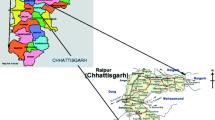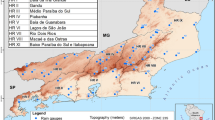Abstract
Extreme value analysis of precipitation is of great importance for several types of engineering studies and policy decisions. For return level estimation of extreme 24-h precipitation, practitioners often use daily measurements (usually 08:00–08:00 local time) since high-frequency measurements are scarce. Annual maxima of daily series are smaller or equal to continuous 24-h precipitation maxima such that the resulting return levels may be systematically underestimated. In this paper we use a rule, derived earlier, on the conversion of the generalized extreme value (GEV) distribution of daily to 24-h maxima. We develop an estimator for the conversion exponent by combining daily maxima and high-frequency sampled 24-h maxima in one joint log-likelihood. Once the conversion exponent has been estimated, GEV-parameters of 24-h maxima can be obtained at sites where only daily data is available. The new methodology has been extended to spatial regression models.







Similar content being viewed by others
References
Ancona-Navarette MA, Tawn JA (2000) A comparison of methods for estimating the extremal index. Extremes 3:5–38
Beirlant J, Goegebeur Y, Segers J, Teugels J (2004) Statistics of extremes. Wiley, Sussex
Blanchet J, Lehning M (2010) Mapping snow depth return levels: smooth spatial modeling versus station interpolation. Hydrol Earth Syst Sci 14:2527–2544
Chandler RE, Bate S (2007) Inference for clustered data using the independence loglikelihood. Biometrika 94:167–183
Chernick MR (1981) A limit theorem for the maximum of autoregressive processes with uniform marginal distributions. Ann Probab 9:145–149
Coles S (2001) An introduction to statistical modelling of extreme values. Springer, Berlin
Coles S, Tawn JA (1996) Modeling extremes of the areal rainfall process. J R Stat Soc B 58:329–347
Cooley D, Nychka D, Naveau P (2007) Bayesian spatial modeling of extreme precipitation return levels. J Am Stat Assoc 102:824–840
Cooley D, Cisewski J, Erhardt R, Jeon S, Mannshardt E, Omolo B, Sun Y (2012) A survey of spatial extremes: measuring spatial dependence and modeling spatial effects. REVSTAT 10:135–165
Davison A (2003) Statistical models, Cambridge Series in Statistical and Probabilistic Mathematics. Cambridge University Press, Cambridge
Davison A, Padoan S, Ribatet M (2012) Statistical modelling of spatial extremes. Stat Sci 27:161–186
Demarée GR (2003) Le pluviographe centenaire du plateau d’Uccle: son histoire, ses données et ses applications. La Houille Blanche 4:1–8
Dwyer IJ, Reed DW (1995) Allowance for discretization in hydrological and environmental risk estimation. Report 123, Institute of Hydrology, Wallingford
Embrechts P, Klüppelberg C, Mikosch T (1997) Modelling extremal events for insurance and finance. Springer, Berlin
Gomes MI (1993) On the estimation of parameters of rare events in environmental time series. In: Barnett V, Turkman KF (eds.) Statistics for the environment 2: water related issues: pp 225–241
Hershfield DM, Wilson WT (1958) Generalizing of rainfall-intensity-frequency data. IUGG/IAHS 43:499–506
Leadbetter MR (1983) Extremes and local dependence in stationary sequences. Z Wahrscheinlichkeit 65:291–306
Leadbetter MR, Lindgren G, Rootzén T (1983) Extremes and related properties of random sequences and processes. Springer, New York
Obeysekera J, Irizarry M, Park J, Barnes J, Dessalegne T (2011) Climate change and its implications for water resources management in south Florida. Stoch Environ Res Risk Assess 25:495–516
Piterbarg VI (2004) Discrete and continuous time extremes of Gaussian processes. Extremes 7:161–177
Pidwirny M (2008) Fundamentals of physical geography, 2nd Ed. PhysicalGeography.net
Ribatet M (2011) SpatialExtremes: an R package for modelling spatial extremes, http://cran.r-project.org/web/packages/SpatialExtremes/
Robinson ME, Tawn JA (2000) Extremal analysis of processes sampled at different frequencies. J R Stat Soc B 62:117–135
Siliverstovs B, Otsch R, Kemfert C, Jaeger CC, Haas A, Kremers H (2010) Climate change and modelling of extreme temperatures in Switzerland. Stoch Environ Res Risk Assess 24:311–326
Smith RL (1990) Regional estimation from spatially dependent data. Unpublished manuscript, University of Chapel Hill
Smith RL, Weissman I (1994) Estimating the extremal index. J R Stat Soc B 56:515–528
Turkman KF (2011) Discrete and continuous time extremes of stationary processes. In: Handbook of statistics. Time series analysis: methods and applications 30:565–582
Van de Vyver H (2012) Spatial regression models for extreme precipitation in Belgium. Water Resour Res 48:W09549
Van de Vyver H (2013) Practical return level mapping for extreme precipitation in Belgium. Publication scientific et technique 62, L’Institut Royal Météorologique de Belgique
van Montfort MAJ (1990) Sliding maxima. J Hydrol 118:77–85
Varin C, Vidoni P (2005) A note on composite likelihood inference and model selection. Biometrika 92:519–528
Weiss LL (1964) Ratio of true to fixed-interval maximum rainfall. J Hydraul Div ASCE 90:77–82
Yoon P, Kim T-W, Yoo C (2013) Rainfall frequency analysis using a mixed GEV distribution: a case study for annual maximum rainfalls in South Korea. Stoch Environ Res Risk Assess 27:1143–1153
Acknowledgments
This work is supported, in part, by the Belgian Science Policy Office (BELSPO) under Contract No. SD/RI/03A.
Author information
Authors and Affiliations
Corresponding author
Rights and permissions
About this article
Cite this article
Van de Vyver, H. On the estimation of continuous 24-h precipitation maxima. Stoch Environ Res Risk Assess 29, 653–663 (2015). https://doi.org/10.1007/s00477-014-0912-5
Published:
Issue Date:
DOI: https://doi.org/10.1007/s00477-014-0912-5




